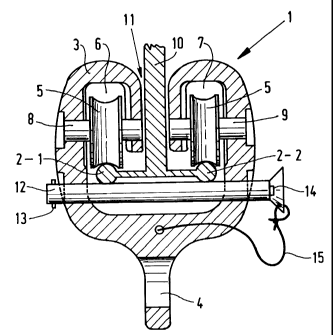Some of the information on this Web page has been provided by external sources. The Government of Canada is not responsible for the accuracy, reliability or currency of the information supplied by external sources. Users wishing to rely upon this information should consult directly with the source of the information. Content provided by external sources is not subject to official languages, privacy and accessibility requirements.
Any discrepancies in the text and image of the Claims and Abstract are due to differing posting times. Text of the Claims and Abstract are posted:
| (12) Patent: | (11) CA 2291533 |
|---|---|
| (54) English Title: | FALL PROTECTION SYSTEM AND TROLLEY FOR USE IN SUCH A SYSTEM |
| (54) French Title: | SYSTEME DE PROTECTION ANTICHUTES ET DISPOSITIF DE SUSPENSION CONNEXE |
| Status: | Deemed expired |
| (51) International Patent Classification (IPC): |
|
|---|---|
| (72) Inventors : |
|
| (73) Owners : |
|
| (71) Applicants : |
|
| (74) Agent: | RIDOUT & MAYBEE LLP |
| (74) Associate agent: | |
| (45) Issued: | 2008-08-05 |
| (22) Filed Date: | 1999-12-03 |
| (41) Open to Public Inspection: | 2000-06-07 |
| Examination requested: | 2004-11-29 |
| Availability of licence: | N/A |
| (25) Language of filing: | English |
| Patent Cooperation Treaty (PCT): | No |
|---|
| (30) Application Priority Data: | ||||||
|---|---|---|---|---|---|---|
|
A fall protection system comprises substantially horizontal anchoring lines and at least one trolley capable of movement along the anchoring lines, which moves with an object to be secured, wherein the anchoring lines are arranged in parallel, spaced relation, and wherein the trolley is provided with multiple running gear which makes contact with each of said anchoring lines. Such a fall protection system is low--noise and low-vibration, and enables easy passage of the trolley along anchoring line supports, without this requiring extra effort and without this limiting the working space and the freedom of movement of the person secured to the fall protection system.
Un système de protection antichutes comprend des lignes d'ancrage sensiblement horizontales et au moins un chariot capable d'un mouvement le long des lignes d'ancrage, qui se déplace avec un objet devant être fixé, dans lequel les lignes d'ancrage sont disposées en parallèle, en relation espacée, et dans lequel le chariot est muni de multiples trains de roulement qui entrent en contact avec chacune desdites lignes d'ancrage. Un tel système de protection antichutes produit peu de bruit et de vibrations, et permet un passage aisé du chariot le long des supports de ligne d'ancrage, sans nécessiter d'effort supplémentaire et sans pour autant limiter l'espace de travail et la liberté de mouvement de la personne attachée au système de protection antichutes.
Note: Claims are shown in the official language in which they were submitted.
Note: Descriptions are shown in the official language in which they were submitted.

For a clearer understanding of the status of the application/patent presented on this page, the site Disclaimer , as well as the definitions for Patent , Administrative Status , Maintenance Fee and Payment History should be consulted.
| Title | Date |
|---|---|
| Forecasted Issue Date | 2008-08-05 |
| (22) Filed | 1999-12-03 |
| (41) Open to Public Inspection | 2000-06-07 |
| Examination Requested | 2004-11-29 |
| (45) Issued | 2008-08-05 |
| Deemed Expired | 2017-12-04 |
There is no abandonment history.
| Fee Type | Anniversary Year | Due Date | Amount Paid | Paid Date |
|---|---|---|---|---|
| Application Fee | $150.00 | 1999-12-03 | ||
| Registration of a document - section 124 | $100.00 | 2000-03-24 | ||
| Maintenance Fee - Application - New Act | 2 | 2001-12-03 | $50.00 | 2001-09-26 |
| Maintenance Fee - Application - New Act | 3 | 2002-12-03 | $50.00 | 2002-09-20 |
| Maintenance Fee - Application - New Act | 4 | 2003-12-03 | $50.00 | 2003-10-06 |
| Maintenance Fee - Application - New Act | 5 | 2004-12-03 | $100.00 | 2004-09-10 |
| Request for Examination | $400.00 | 2004-11-29 | ||
| Maintenance Fee - Application - New Act | 6 | 2005-12-05 | $100.00 | 2005-09-16 |
| Maintenance Fee - Application - New Act | 7 | 2006-12-04 | $100.00 | 2006-09-07 |
| Maintenance Fee - Application - New Act | 8 | 2007-12-03 | $100.00 | 2007-11-29 |
| Final Fee | $150.00 | 2008-05-20 | ||
| Maintenance Fee - Patent - New Act | 9 | 2008-12-03 | $100.00 | 2008-09-03 |
| Maintenance Fee - Patent - New Act | 10 | 2009-12-03 | $125.00 | 2009-09-25 |
| Maintenance Fee - Patent - New Act | 11 | 2010-12-03 | $125.00 | 2010-09-28 |
| Maintenance Fee - Patent - New Act | 12 | 2011-12-05 | $125.00 | 2011-10-17 |
| Maintenance Fee - Patent - New Act | 13 | 2012-12-03 | $125.00 | 2012-10-25 |
| Maintenance Fee - Patent - New Act | 14 | 2013-12-03 | $125.00 | 2013-10-02 |
| Maintenance Fee - Patent - New Act | 15 | 2014-12-03 | $225.00 | 2014-11-07 |
| Maintenance Fee - Patent - New Act | 16 | 2015-12-03 | $225.00 | 2015-10-07 |
Note: Records showing the ownership history in alphabetical order.
| Current Owners on Record |
|---|
| ZIET VERDER BEHEER B.V. |
| Past Owners on Record |
|---|
| WESTERWEEL, JOZEF MARIA |